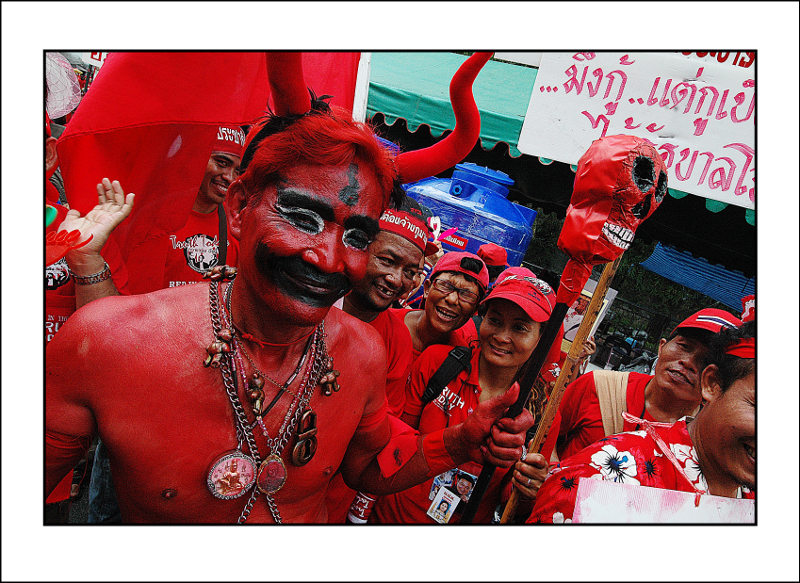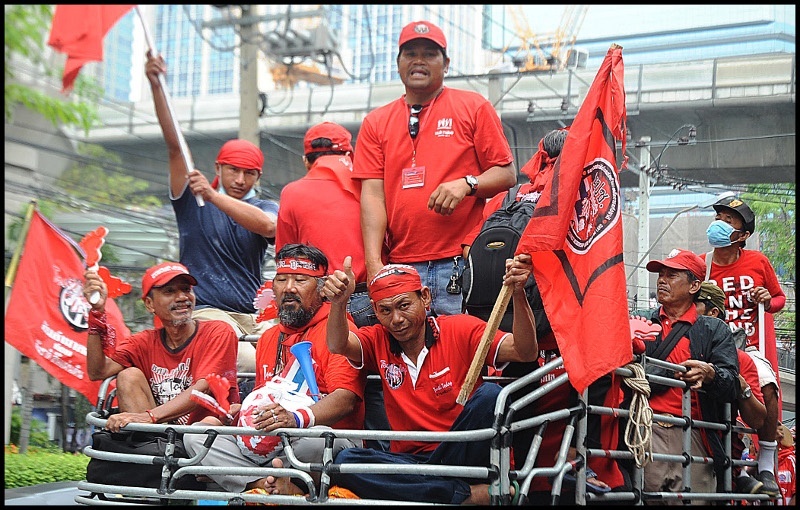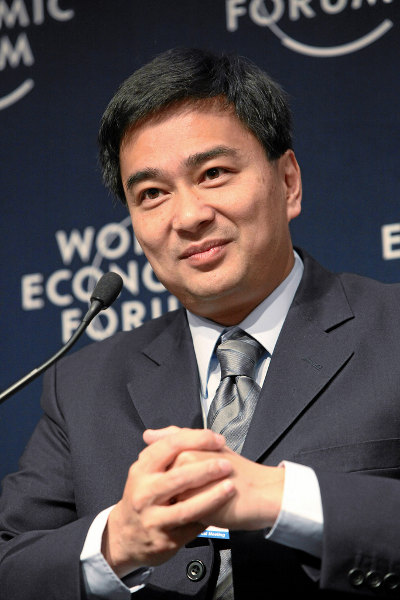What is going on in Thailand? What do the yellow and red shirt movements represent? Leaders of the Red Shirts have been pressurising Prime Minister Abhisit Vejjajiva to step down and call elections after weeks of protests that have shaken the country. Here our correspondent gives some background information to the conflict presently unfolding in the country.
Prime Minister Abhisit Vejjajaya sleeps only three to five hours a night at the base of the Royal Guards 11th infantry regiment. Outside and all around the redshirts are sleeping. It’s a slack time for the rice growers and they are in no hurry. Parliament cannot meet as less than 100 members arrive for the sessions, and the demonstrators play cat and mouse with the cabinet, sometimes allowing it to meet to arrange negotiations and to avoid giving an excuse for a military crackdown. With 3000 motorcycles and numerous trucks the redshirts stop the city on a busy Saturday afternoon.
Press reports in Bangkok and abroad, skilfully manipulated, present a picture of an opposition in decline, with support for Thaksin Shinawatra being nothing but rent-a-crowd, that it had peaked last year, and had fizzled out with the failure to stop the world Trade Conference – and yet it continues. With 100,000 demonstrators heading for the capital police claimed they were only expecting 10,000 and the next day announced that demonstrators were drifting away and the number had gone down to 90,000.
Tuesday, March 30, the anti-government "Red Shirt" protestors rejected the prime minister's offer of more talks, as these were seen as merely a manoeuvre to avoid calling early elections. Thus the mass protest rallies in Bangkok have continued.
The question that has to be asked is how is it possible that a mass movement initially of poor farmers from Isan, the rural north of Thailand, is showing such persistence and determination in support of a politician Thaksin who started as the richest man in the country, went on to enrich himself and his family through corrupt business activities while in power and was overthrown in a military coup with royal consent after mass protests by the ‘yellow shirts’?
In 2001 Thaksin won a landslide victory in the elections of that year, becoming the country’s prime minister. He was also the first to serve the full term of office. Thaksin went on to introduce a range of policies to alleviate rural poverty which proved highly popular. Thaksin, in typical populist fashion, leaned on the poor layers within the population and carried through some small but significant reforms. The 30 Bhat health service made hospital treatment a real possibility for many and there was talk of advances in education and subsidies for small farmers and low-interest village loans. Thailand's impoverished, mainly rural masses benefitted materially from Thaksin’s period in office. This explains why his re-election in 2005 saw the highest voter turnout in Thai history. However, in September 2006, with allegations against him of tax evasion, corruption, human rights abuses and so on, a military coup, with the backing of the monarchy, was carried out which removed him from office.
 UDD protest in Bangkok last year. Photo by adaptorplug. Today’s “Red Shirt” movement is made up of supporters of Thaksin, largely from among the country's rural and urban poor, that want to see him back in office. Its leaders have portrayed the demonstrations as a struggle between Thailand's impoverished, mainly rural masses, but also urban poor — who benefited from Thaksin policies— and a Bangkok-based wealthy elite.
UDD protest in Bangkok last year. Photo by adaptorplug. Today’s “Red Shirt” movement is made up of supporters of Thaksin, largely from among the country's rural and urban poor, that want to see him back in office. Its leaders have portrayed the demonstrations as a struggle between Thailand's impoverished, mainly rural masses, but also urban poor — who benefited from Thaksin policies— and a Bangkok-based wealthy elite.
What we are witnessing now is essentially a split in the tiny ruling elite which networks at the highest level in the army, the police, the political life of the country, and controls much of the economy. Thailand is as profoundly corrupt as any country in the world in its obscene and conspicuous contrast between rich and poor, town and countryside. The poorest 10% of the population consumes only 1.6% of national wealth, while the richest 10% concentrates 33.7% of national income in its hands.
Bangkok has the sky train, multi screen cinemas, vast glittering shopping complexes and underground malls where you can pop in for the best gold, gems and jewellery, designer clothes, celebrity sponsored golf clubs or a new Ferrari, while village people live in grinding poverty, often growing rice on tiny plots of land using a plough pulled by water buffalo.
The seedy industries for which Thailand is well known have their origins in the class division between anmart (bureaucrats or aristocrats) and phrai, or commoners and can be understood in the context of social conditions and low status enjoyed by the poor farmers. The bar girls in Soi Cowboy and older women in the sex industry appear undernourished compared to the tourists on the beach in Pattaya. Nearly all are working to support children who live with the grandmother in a village. The begging industry is fully Dickensian with businessmen of the street leading their captive cripples to prime sites to be artistically displayed spreading out the frayed trouser legs with no leg inside, for example, positioning a cute puppy in the arms of the beggar and studying from a safe distance the emotional impact on Japanese tourists leaving the Tokyu department store.
Pornographic DVDs are sold openly and even aggressively in certain streets and electronic shopping plazas and it is impossible to search for foreign visas without getting adverts for meetings with ladyboys. Bangkok is no worse than the contents of an email spam folder but opened up and brought to life. The paedophile element is also unmistakeable.
Even the Thai brides export industry has its roots in rural poverty. It must be accepted that there can be genuine loving relationships between foreign men and Thai women, and that some foreign men marry into Thai extended families and it goes well for them. It cannot be denied, however that only in Thailand would you expect to meet a newly released grossly obese murderer from Australia drinking himself to death in a bar, who has come to find a Thai woman because she would “not answer him back”, or to come across a painfully shy and inarticulate farmer who has never had a girlfriend and hopes for better luck in Thailand or a man over 60 looking for a teenage girl. The outside world is literally invited to use the country as a playground and exploit the poverty of the ordinary people – just as the local ruling class has always done.
Some countries can maintain stability of a sort by living a lie. Indonesia for example is the biggest Islamic country in the world and 95% of its people are Muslims, but when you start to add up the number of Christians, Hindus Buddhists and animists and take into account that it is illegal to have no religion or to have a belief not in the list of seven approved religions, it is clear that non-Muslims are closer to 30% than 5%. Thailand has its own untruths which all must accept: the country is united because there are no classes; all must be happy because they are Buddhist and all Thais love the King (except for the Muslims in the South and in small fishing villages who are not regarded as Thais except when they demand political autonomy).
 Protest outside the US embassy in March. Photo by adaptorplug. So Thais supposedly love the king they say so and they stand for the national anthem right to the end. They love the king as Russians loved the Czar up to February 1917, or as Iranians loved the Shah before 1979 – and then he was gone. We are supposed to believe that they love this King even more because he was once a monk, because he leads a simple life close to his people, because he is old and ill and because he brought rain to the farmers. And they loved him most of all because he gave them democracy... until of course he took that democracy away from them.
Protest outside the US embassy in March. Photo by adaptorplug. So Thais supposedly love the king they say so and they stand for the national anthem right to the end. They love the king as Russians loved the Czar up to February 1917, or as Iranians loved the Shah before 1979 – and then he was gone. We are supposed to believe that they love this King even more because he was once a monk, because he leads a simple life close to his people, because he is old and ill and because he brought rain to the farmers. And they loved him most of all because he gave them democracy... until of course he took that democracy away from them.
Red shirts and yellow shirts compete in their displays of loyalty but, expressed in silence for fear of imprisonment, the future of the monarchy is in serious doubt. Thaksin and his allies won the last three general elections but the results were set aside by the King and the Army under pressure from the yellow shirt movement, said to represent the middle class and urban elite in Bangkok. First Thaksin was forced to call a new election, which he won, then he was persuaded by the King personally to stand down but delayed the move and was overthrown in a military coup supported by the Democrats. The king called for a rapid return to democracy but Thaksin’s allies gained a majority. Then followed an organized betrayal (comparable to the National Government of Ramsay Macdonald in the UK in 1931 when Labour leaders crossed the floor of the House following an appeal by the monarchy).
The last issue of The Economist was said to run an article questioning the future of the monarchy and this has not been circulated in Thailand. It is likely to focus on the issue of succession as the heir is less loved than the King but in the long run the issue is not the personality of the monarch but the limitations of a democracy which is permitted as long as the right side wins. As in Nepal recently, the Thai monarch’s position is in question. He has been seen more and more using his constitutional powers to remove from office politicians not to the liking of the elite, and in particular Thaksin who is seen by the masses as having carried out some pro-poor policies. The demand for the removal of the monarchy is clearly one that has to be taken up by the movement.
So far the protests have been non-violent and the army have controlled crowds without the use of force. There have been a few provocative hand grenade attacks on government buildings by men with military style haircuts but the spirit of Buddhism rules – for now. It is also obvious from the swagger and arrogance of the military top brass that they are prepared to drown the protests in blood as soon as they calculate that they can win, but at present they are deterred by the polls showing that 85% of people here want the crisis to be solved by negotiation and there must be doubts about loyalty of the lower ranks.
Thaksin has played the class card, claiming to be the leader of the Phrai despite his extreme wealth and extravagant lifestyle. In this way a split within the ruling class, combined with an inability to rule in a way that carries society forwards, has opened up the more fundamental division between the oppressed and their oppressors. The rice farmers are now touring Bangkok in motorcades appealing for support from the pedlars, stall holders and the lower paid workers – and getting that support. They also have the possibility of making a class appeal to the lower ranks of the army, including many recruited from Isan and the other rural areas.
The red shirts would win if there were a free and fair election and now carry a great weight on their shoulders. Thailand fell so far behind its neighbours Malaysia, Singapore and South Korea in a boom time that any redistribution of wealth would not be sufficient to bring their living standards up to a reasonable level. New wealth has to be created in the economy and the labour theory of value tells us that all wealth comes from a single source, socially necessary labour power. Work creates value, in other words, but not just any work. It must be unwasted, effective and efficient work, using current tools and equipment, transport and communications with a skilled and educated workforce.
The Thai elite failed to modernize the country during the decades of unprecedented advances for capitalist production in Asia, and is less likely to achieve much now that the world markets are returning to the more normal pattern of booms, slumps and stagnation. The redshirts have given small amounts of blood to be splattered on the steps of government buildings and used by artists for a display to be wrapped around the Victory monument. In this symbolic act they show an understanding that the smiling face of a nice kind king looking down from the wall in every building and the reassuring chants and chimes of the Buddhist monks are no indication that the army can be trusted. If their campaign should lose momentum temporarily there will be arrests followed by real bloodshed and death.
However, it is also very clear that the underlying class contradictions are what are fuelling the movement. The present regime will not be able to hold the line for ever. As the movement from below becomes stronger it is possible the campaign will bring back Thaksin. Should the situation become like that in Nepal, the ruling elite may even be forced to ditch the monarchy as a way of appeasing the masses. The present leadership of the movement could be swept along or pushed aside by the masses of poor farmers and low paid workers.
During the boom years of 2000 to 2008 the country averaged more than 4% GDP growth per year. This has served to strengthen the working class. GDP per capita today stands at over $8000 per year, which although low compared to the major advanced capitalist countries, is an indication of the economic development the country has undergone in recent years. In 2009, however, GDP is estimated to have fallen by close to 3% as a result of the worldwide economic recession that seriously affected the country’s exports. This underlying economic crisis, serves to explain also the present movement and also a spate of strikes over the past period.
Out of Thailand’s 65 million population there is now a 36 million-strong labour force, but only 3% are organized in trade unions. But that still makes over one million trade union members. Trade union rights, however, are very limited. Even the US Department of State – not the most worker friendly body in the world – has to admit that there is “inadequate protection of worker rights” and also “forced labor and child labor” in Thailand.
In spite of the limited trade union rights, Thailand has recently witnessed important strikes. One such case was the months long protest of workers against Body Fashion Thailand Co, a subsidiary of Triumph International, which fired them last June. About 300 ex-workers occupied the ground floor of the Ministry of Labour. Another recent example is that of 2,000 Burmese female workers who ended a strike only after the authorities located a relative of a worker, who had earlier been thought to have been killed by security officers of the factory. At the Ford-Mazda joint venture car manufacturing plant, workers recently came out on strike for better pay and bonus terms. There was also an important rail dispute in November of last year.
These are just a few examples of labour disputes, but they show that the working class is a strong force within the country. Unfortunately, the Thai working class does not have a voice of its own. In the past the country had a powerful Communist Party and at one point it led the second largest communist movement in mainland South-East Asia after Vietnam with up to four million supporters in the 1970s. Due to the demise of Stalinism in the Soviet Union and other factors, eventually the party collapsed in the early 1990s. Since then, there has been no real independent voice of the Thai workers and peasants.
What is required today is the building of a genuine party of the Thai working class, one that is capable of intervening in the present movement and placing the working class at the head of the people’s protest. All the potential for such a party exists today in Thailand.

